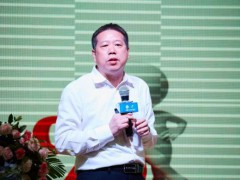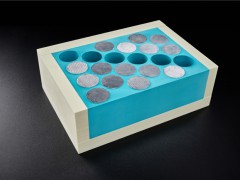劍橋大學的研究人員開發出了一種名為“人造樹葉”的太陽能技術,它可以一步將二氧化碳和水轉化為高能量密度的燃料,如乙醇和丙醇
與生物燃料和化石燃料不同,這些太陽能燃料不會造成碳排放,也不需要農業用地來生產,提供了一種可再生的凈零碳解決方案
這種技術仍處于早期階段,團隊目前正在努力提高設備的效率,優化其吸收陽光和增加燃料產量的能力,并擴大設備規模以實現大量燃料生產
據油價網2023年8月4日報道,劍橋大學的研究人員已經開發出了一種太陽能技術,可以將二氧化碳和水轉化為液體燃料,這種燃料可以作為即用型燃料直接添加到汽車發動機中。
劍橋大學研究人員在《自然能源》雜志上報道了這項新技術。
劍橋大學研究人員利用光合作用的力量,一步將二氧化碳、水和陽光轉化為多碳燃料——乙醇和丙醇。這些燃料能量密度高,易于儲存或運輸。
與化石燃料不同,這些太陽能燃料的凈碳排放量為零,完全可再生,而且與大多數生物乙醇不同,它們不會占用任何用于糧食生產的農業用地。
雖然這項技術仍處于實驗室規模,但研究人員表示,他們的“人造樹葉”是從化石燃料經濟轉型的重要一步。
生物乙醇被譽為汽油的清潔替代品,因為它是由植物而不是化石燃料制成的。如今上路的大多數汽車和卡車使用的汽油含有高達10%的乙醇(E10燃料)。美國是世界上最大的生物乙醇生產國:根據美國農業部公布的數據,美國種植的所有玉米產量中幾乎有45%用于乙醇生產。
領導這項研究的歐文·賴斯納(Erwin Reisner)教授指出:“像乙醇這樣的生物燃料是一項有爭議的技術,尤其是因為它們占用了可以用來種植糧食的農業用地。”
幾年來,賴斯納在尤瑟夫·哈米德化學系的研究小組一直在利用“人造樹葉”開發受光合作用(植物將陽光轉化為食物的過程)啟發的可持續的零碳燃料。
到目前為止,這些“人造樹葉”只能制造簡單的化學物質,比如合成氣,一種氫和一氧化碳的混合物,用于生產燃料、藥品、塑料和化肥。但為了使這項技術更實用,它需要能夠在一次單一的太陽能步驟中直接生產更復雜的化學物質。
現在,“人造樹葉”可以直接生產清潔的乙醇和丙醇,而不需要中間步驟生產合成氣。
研究人員開發了一種銅鈀基催化劑。這種催化劑經過優化,可以讓“人造樹葉”產生更復雜的化學物質,特別是多碳醇類乙醇和正丙醇。這兩種醇都是高能量密度的燃料,易于運輸和儲存。
其他科學家已經能夠利用電力生產類似的化學物質,但這是第一次僅使用太陽能利用“人造樹葉”生產如此復雜的化學品。
此研究論文的第一作者Motiar Rahaman博士提供了更多細節,“將陽光照射在‘人造樹葉’上,并從二氧化碳和水中獲得液體燃料是一種驚人的化學反應。通常,當你試圖用‘人造樹葉’裝置將二氧化碳轉化為另一種化學產品時,你幾乎總是得到一氧化碳或合成氣,但在這里,我們已經能夠生產出一種實用的液體燃料,只需要利用太陽能。這是一個令人興奮的進步,為我們的研究工作開辟了全新的途徑”。
目前,這個設備只是一個概念驗證,僅顯示出適度的效率。劍橋大學研究人員正在努力優化光吸收器,使其能夠更好地吸收陽光,并優化催化劑,使其能夠將更多的陽光轉化為燃料。進一步的工作還需要使該設備可擴展,以便生產大量的燃料。
“盡管還有很多工作要做,但我們已經展示了這些“人造樹葉”的能力,”賴斯納教授說,“重要的是,我們可以超越最簡單的分子,在我們從化石燃料過渡的過程中,制造出直接有用的東西。”
這項研究得到了歐盟委員會瑪麗斯克沃多夫斯卡-居里獎學金,劍橋信托基金,以及溫頓可持續發展物理學項目的部分支持。Erwin Reisner是劍橋大學圣約翰學院研究員,Motiar Rahaman是劍橋大學圣約翰學院副研究員。
“人造樹葉”技術是一個相當廣泛的想法,利用太陽能來執行或驅動反應。從二氧化碳和水變成燃料似乎是個好主意。
但仍有很多問題需要解決。雖然讓水和二氧化碳接近并不困難,但要找到合適的條件可能很難。比例、溫度、污染、能量輸入水平和其他相關因素參數都必須計算出來,然后制造出具有經濟意義的“人造樹葉”。
這很可能是可以做到的,也應該做到。但直到數億年前,大自然才發現,氫與碳相連,可以儲存能量,形成有用的分子。大多數重大科技進步都是在漫長時光中徐步而來。就碳氫化合物而言,至少到目前為止,大自然尚未找到更好的方式。
這表明這項技術可能是最好的想法之一,希望該研究前景光明。
李峻 譯自 油價網
原文如下:
Pioneering Tech Turns Sunlight And CO2 Into Renewable Fuel
· Researchers from the University of Cambridge have developed a solar-powered technology, called "artificial leaves," which can convert carbon dioxide and water into high energy density fuels such as ethanol and propanol in a single step.
· Unlike biofuels and fossil fuels, these solar fuels do not contribute to carbon emissions and do not require agricultural land for their production, offering a renewable and net zero carbon solution.
· The technology is still in its early stages, with the team currently working on enhancing the device's efficiency, optimizing its ability to absorb sunlight and increase fuel production, and scaling up the device to enable large volumes of fuel production.
University of Cambridge researchers have developed a solar-powered technology that converts carbon dioxide and water into liquid fuels that can be added directly to a car’s engine as drop-in fuel.
The researchers report on the new technology in Nature Energy.
The researchers harnessed the power of photosynthesis to convert CO2, water and sunlight into multicarbon fuels – ethanol and propanol – in a single step. These fuels have a high energy density and can be easily stored or transported.
Unlike fossil fuels, these solar fuels produce net zero carbon emissions and completely renewable, and unlike most bioethanol, they do not divert any agricultural land away from food production.
While the technology is still at laboratory scale, the researchers say their ‘artificial leaves’ are an important step in the transition away from a fossil fuel-based economy.
Bioethanol is touted as a cleaner alternative to petrol, since it is made from plants instead of fossil fuels. Most cars and trucks on the road today run on petrol containing up to 10% ethanol (E10 fuel). The United States is the world’s largest bioethanol producer: according to the U.S. Department of Agriculture, almost 45% of all corn grown in the US is used for ethanol production.
Professor Erwin Reisner, who led the research noted, “Biofuels like ethanol are a controversial technology, not least because they take up agricultural land that could be used to grow food instead.”
For several years, Reisner’s research group, based in the Yusuf Hamied Department of Chemistry, has been developing sustainable, zero-carbon fuels inspired by photosynthesis – the process by which plants convert sunlight into food – using artificial leaves.
To date, these artificial leaves have only been able to make simple chemicals, such as syngas, a mixture of hydrogen and carbon monoxide that is used to produce fuels, pharmaceuticals, plastics and fertilisers. But to make the technology more practical, it would need to be able to produce more complex chemicals directly in a single solar-powered step.
Now, the artificial leaf can directly produce clean ethanol and propanol without the need for the intermediary step of producing syngas.
The researchers developed a copper and palladium-based catalyst. The catalyst was optimized in a way that allowed the artificial leaf to produce more complex chemicals, specifically the multicarbon alcohols ethanol and n-propanol. Both alcohols are high energy density fuels that can be easily transported and stored.
Other scientists have been able to produce similar chemicals using electrical power, but this is the first time that such complex chemicals have been produced with an artificial leaf using only the energy from the Sun.
Dr Motiar Rahaman, the paper’s first author offered more details, “Shining sunlight on the artificial leaves and getting liquid fuel from carbon dioxide and water is an amazing bit of chemistry. Normally, when you try to convert CO2 into another chemical product using an artificial leaf device, you almost always get carbon monoxide or syngas, but here, we’ve been able to produce a practical liquid fuel just using the power of the Sun. It’s an exciting advance that opens up whole new avenues in our work.”
At present, the device is a proof of concept and shows only modest efficiency. The researchers are working to optimize the light absorbers so that they can better absorb sunlight and optimizing the catalyst so it can convert more sunlight into fuel. Further work will also be required to make the device scalable so that it can produce large volumes of fuel.
“Even though there’s still work to be done, we’ve shown what these artificial leaves are capable of doing,” said Reisner. “It’s important to show that we can go beyond the simplest molecules and make things that are directly useful as we transition away from fossil fuels.”
The research was supported in part by the European Commission Marie Sk?odowska -Curie Fellowship, the Cambridge Trust, and the Winton Program for the Physics of Sustainability. Erwin Reisner is a Fellow and Motiar Rahaman is a Research Associate of St John’s College, Cambridge.
The artificial leaf technology is quite a wide array of ideas using solar energy to perform or drive reactions. Going from carbon dioxide and water to a fuel seems like a great idea.
There is a lot to work out. While getting the water and CO2 in proximity isn’t difficult, getting the conditions right might be. Proportions, temperatures, contaminates, energy input levels and other incident parameters all have to be worked out and then manufacture leaves that make economic sense.
It very likely can be done and should be. But it was hundreds of millions of years ago nature figured out to store energy with hydrogen connected to carbon for useful molecules. Most of the big advancements have been set for a very long time. So far nature hasn’t turned up anything better.
That suggests this tech might be among the very best ideas. Lets hope development continues.
免責聲明:本網轉載自其它媒體的文章及圖片,目的在于弘揚石化精神,傳遞更多石化信息,宣傳國家石化產業政策,展示國家石化產業形象,參與國際石化產業輿論競爭,提高國際石化產業話語權,并不代表本網贊同其觀點和對其真實性負責,在此我們謹向原作者和原媒體致以崇高敬意。如果您認為本站文章及圖片侵犯了您的版權,請與我們聯系,我們將第一時間刪除。







